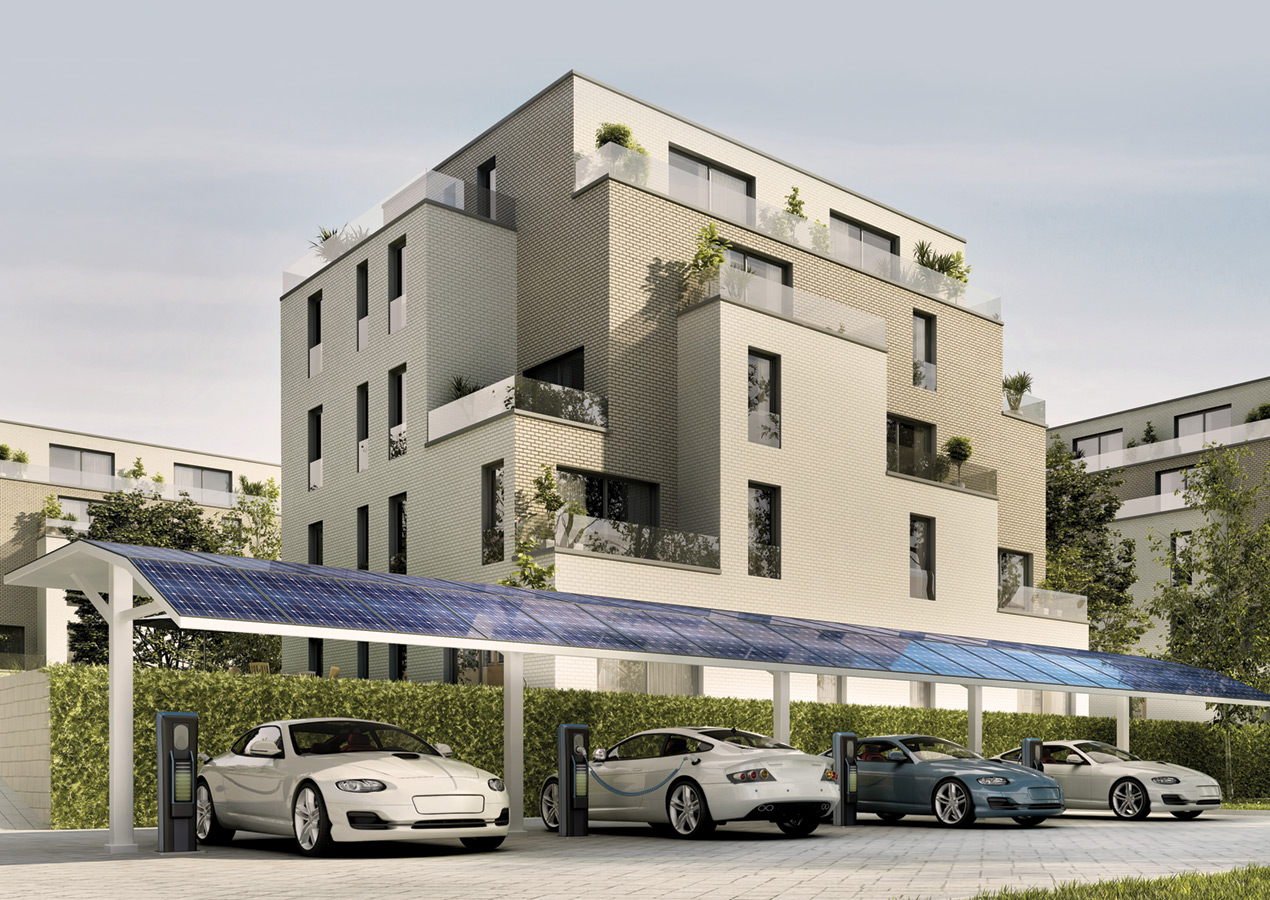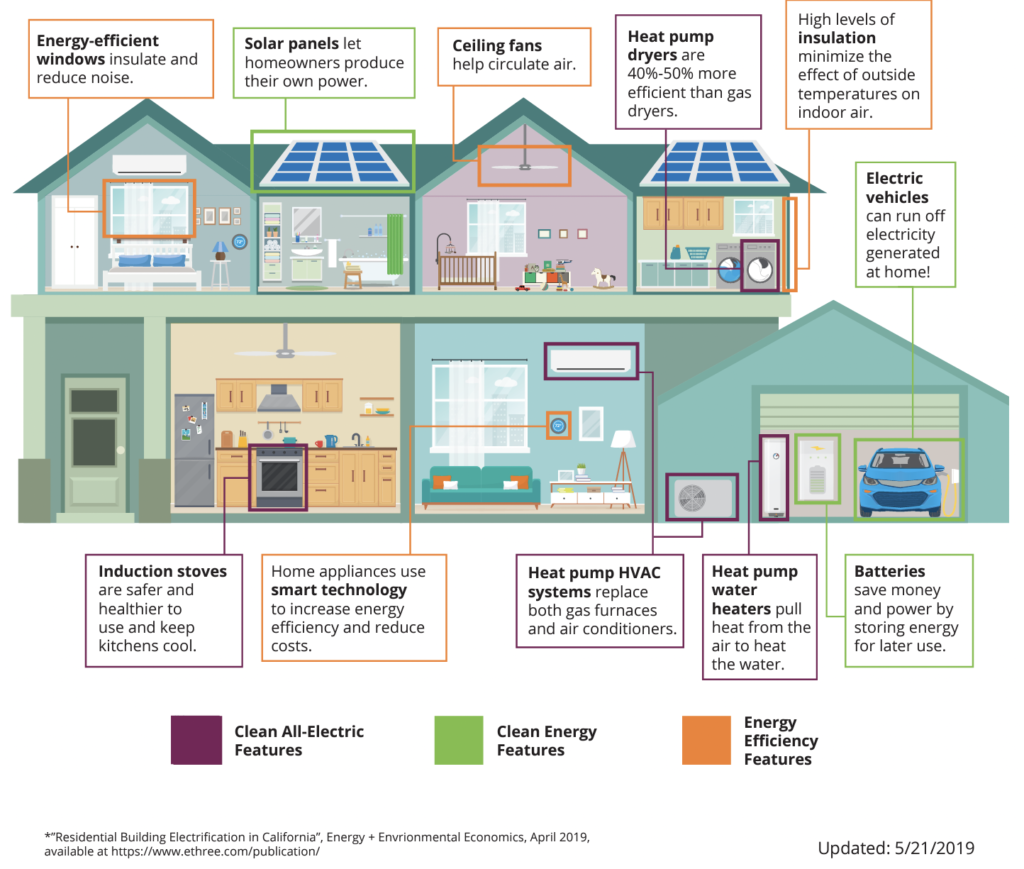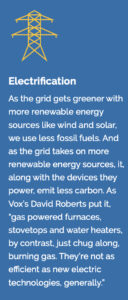By George Burmeister, Colorado Energy Group September 24, 2021

Americans concerned about cleaner energy choices and improved equity for their communities, electrification has tremendous momentum and is moving ahead at breakneck speed. And it’s coming to a community near you. © sl-f
Thanks to dramatic cost declines and thousands of large solar projects coming on-line, electrification of the buildings and transportation sectors, along with the decarbonization of the electricity grid, is probably the biggest front-page news in the energy industry since deregulation.
This time, however, it’s not state regulators, utility lawyers and independent power consultants grabbing the headlines. Instead, it’s solar advocates, Sierra Club members and activist moms concerned about climate change and dangerous levels of indoor air pollution from natural gas heating and cooking who are on the front lines for the health and safety of their children and our planet. These advocates, partnering with millions of citizens and a handful of innovative electric utilities like Southern California Edison, are part of a united effort to aggressively reduce greenhouse gas (GHG) emissions and implement bold climate action strategies by electrifying our building and transportation sectors.
While these leaders and events are crucial, to be clear, without new, clean solar-generated electricity, there would be no electrification momentum. Solar electricity makes electrification and significant GHG reductions possible.

Anatomy of an all-electric home. © Southern California Edison Company
California leads the country on electrification.1 After an extensive public comment period, on August 11, 2021, the California Energy Commission adopted energy efficiency standards for new construction and renovations, the country’s first statewide building code that incentives all-electric construction. Effective in January 2023, the 2022 Energy Code encourages electric heat pumps for space and water heating, expands solar and battery storage standards and adopts electric-ready requirements for single-family homes. Other states, notably Colorado, are embracing electrification, and many more are likely to take notice and pursue similar standards.
 Whether spurred on by the extra time spent indoors during the pandemic, where we learned more about our energy use and its impact on indoor and outdoor air quality, the actions of emissions-focused public interest groups, or a new generation of Americans concerned about cleaner energy choices and improved equity for their communities, electrification has tremendous momentum and is moving ahead at breakneck speed. And it’s coming to a community near you.
Whether spurred on by the extra time spent indoors during the pandemic, where we learned more about our energy use and its impact on indoor and outdoor air quality, the actions of emissions-focused public interest groups, or a new generation of Americans concerned about cleaner energy choices and improved equity for their communities, electrification has tremendous momentum and is moving ahead at breakneck speed. And it’s coming to a community near you.
Electrification: Underpinned with Sound Science
Despite the recent lack of science-based decisions at the federal level, some of the greatest minds in our national laboratories and the clean energy space are providing new GHG-related analyses to utilities, cities and states and their consultants. Major electrification initiatives are underway at the Rocky Mountain Institute (RMI), the Natural Resources Defense Council (NRDC), the Regulatory Assistance Project (RAP), Lawrence Berkeley National Laboratory (LBNL), the National Renewable Energy Laboratory (NREL) and the Electric Power Research Institute (EPRI). In an updated 2018 report,2 RMI compared the cost of building an all-electric single-family home to a gas-fired home in seven cities around the U.S. The findings revealed that the all-electric homes saved money and reduced carbon pollution in every case. Additionally, running natural gas lines to new homes and maintaining them over decades is expensive. RMI found that up-front costs can be as much as $24K per home.
These initiatives acknowledge that end-use electrification coupled with the decarbonization of electricity generation is a key pathway to achieving a low-carbon future in the United States. In our lifetime.
The Numbers
In June 2021, the Solar Energy Industries Association (SEIA) announced that the U.S. solar market surpassed 100 gigawatts (GWdc) of installed electric generating capacity, doubling the size of the industry over the last 3.5 years. Solar had a record-setting Q1 2021 and accounted for 58% of all new electric capacity additions in the United States.3
- Renewable energy accounted for nearly 100% of all new electric capacity in Q1. Utility-scale renewables now account for 24.77% of the total of all installed generating capacity and expanded their lead over coal (19.28%).4
- On August 5, 2021, President Biden signed an executive order that sets a target that half of all vehicles sold in the U.S. be electric by 2030. U.S. automakers pledged 40 to 50% of new car sales will be electric by 2030.5
- More than 2,011 jurisdictions in 34 countries have declared a climate emergency. Populations covered by jurisdictions that have declared a climate emergency amount to over one billion people.6
- More than 60 California cities including Berkeley, Ojai, San Francisco, and San Jose have, or are considering, banning natural gas in future buildings based on health and safety reasons, or based on energy/GHGs as part of a “reach code.” Los Angeles and Los Angeles County are aggressively working on electrification initiatives as well.7
 A meta-analysis looking at the association between gas stoves and childhood asthma found children in homes with gas stoves have a 42% increased risk of experiencing asthma symptoms (current asthma), a 24% increased risk of ever being diagnosed with asthma by a doctor (lifetime asthma), and an overall 32% increased risk of both current and lifetime asthma.8
A meta-analysis looking at the association between gas stoves and childhood asthma found children in homes with gas stoves have a 42% increased risk of experiencing asthma symptoms (current asthma), a 24% increased risk of ever being diagnosed with asthma by a doctor (lifetime asthma), and an overall 32% increased risk of both current and lifetime asthma.8
Community Choice Energy (CCE): Empowered Communities Changing the Energy Landscape
Formerly known as community choice aggregation (CCA), CCEs may be managed by a city or county, or by a third party through a contractual arrangement – typically a Joint Powers Authority (JPA). The CCE purchases electricity for its customers and the IOU manages transmission, distribution, metering, and billing. Importantly, CCEs are statutorily required to be an opt-out program; residents are automatically enrolled in the CCE but can choose to opt-out to continue full IOU service. On average, 94% of customers stay with the new CCE.
Mostly located in California, CCEs must adhere to state rules and regulations and meet the state’s Renewable Portfolio Standard (RPS), but the state does not oversee ratemaking for the CCE. CCEs can purchase solar and wind and run their own renewable energy programs, which they do at an astonishing rate.
The first CCEs became operational in the early 2010s. After the concept proved viable, CCEs took off. Currently, California has 23 CCEs comprised of more than 200 jurisdictions and serving 11 million customers, or 28% of the state’s electric load. To date, CCEs have contracted for more than 6 GWs of new clean generation capacity – roughly enough energy to power three million homes (considering power losses, geography, and other factors). CCEs are expected to account for 90% of the new energy procurement needed in California by 2030.9
Most CCEs in the state chose to procure more renewable energy power than offered by their IOUs, with a supermajority procuring at least 70% of their electricity from renewable (including hydropower) resources. California’s RPS targets 50% renewable electricity by 2026, 60% by 2030, and 100% carbon-free electricity by 2045.
The Southern California Edison Company…Raising the Bar
Realizing that meeting California’s 2045 GHG goals required a near-complete transformation of how the state sources and uses energy across all sectors of the economy, the electric utility Southern California Edison Company (SCE), has taken an early lead in the race to decarbonize electricity and electrify California’s buildings and transportation sectors. In 2017, SCE published Pathway 2045,10 a foundational analysis of actions needed to meet the State’s interim 2030 goals. Working with other IOUs and CCEs, SCE has led state policymakers and regulators on the issue, receiving high marks from environmental and climate activist communities. SCE has three major near-term electrification goals to meet carbon neutrality by 2045:
- Transform 70% of all buildings in their service territory with efficient electric space and water heating (all-electric homes generate 90% fewer GHG emissions than mixed-fuel homes).
- Decarbonize electricity and achieve 100% of retail sales from carbon-free electricity, while ensuring that 50% of all single-family homes include solar panels.
- Transform 75% of the automotive fleet to electric vehicles (EVs). SCE’s recently launched ChargeReady Program is on track to install 38,000 new EV chargers – the largest utility-run electric passenger vehicle charging infrastructure program in the nation.

Figure one. © California Air Resources Board
It Takes Two: Buildings Electrification and Transportation Electrification
SCE’s focus on transportation electrification is appropriate since (as shown in Figure 1) transportation is the biggest source of air pollution and GHGs in California. Along with CCEs and municipal utilities that are investing hundreds of millions of dollars in renewables, SCE is creating a foundation for clean electric transportation fuel for electric vehicles (EVs) in southern California. As battery costs continue to decline, EV ranges are extended and charging infrastructure is expanded, millions more people are expected to drive EVs.
The stakes are huge and the transition must be managed carefully since one EV can use as much energy as a small home. And while new building technologies are exciting to consider, it’s equally exciting to think about an EV powering a home and vice versa (bi-directional charging), and vehicle-to-grid (V2G) programs where numerous EV batteries plugged in at home or business are aggregated and controlled from one central location. In the short term, incentivizing the use of less natural gas through new rates can be as impactful on GHGs as new building codes.
Electrifying Our Homes, Starting with (Where Else) the Kitchen
Evolution has come a long way since the discovery of fire. Nowhere is the conversation about electric versus gas technology more heated than in our kitchens. In the mid-nineteenth century, England was at home with gas cooking. And while gas ranges were being exported, the U.S. generally considered gas too expensive a fuel to use for cooking. Rumors of a distinct after-taste were also common.
Although electric ovens began to compete with gas in the early 1930s, the technology and distribution networks were rudimentary. But when electric power companies began to make inroads into lighting, the primary market for gas, the gas industry redirected its efforts from lighting to cooking.
Originated in the mid to late 1930s, the catchy Cooking with Gas campaign was designed to recapture market share by convincing people to use gas rather than electricity in the kitchen. Gas, we were told, was clean. You could control the flame. No burned food. Chefs loved it. For years, electric cooktops were dismissed by home cooks and culinary professionals. However, as electric cooking technologies advanced, along with the heightened awareness about the dangers of fossil fuel combustion in our homes, the natural gas industry pivoted again. In a not-so-surprising move in 2020, the industry revived its nearly century-old Cooking with Gas campaign in hopes of recapturing and maintaining its kitchen dominance.11
In addition to the Cooking with Gas campaign, pro gas groups with obscure missions like The Empowerment Alliance and Partnership for Energy Progress have emerged to sway opinion away from electrification.
One of the most controversial of these pro-gas groups, drawing national media attention over the past two years, is Californians for Balanced Energy Solutions (C4BES), a coalition of natural and renewable gas users. Its goal, according to its website, is “…to educate Californians about the importance of natural and renewable gas for improving the environment and providing for a strong economy….”12 The California Ratepayer Advocate’s Office recommended that the country’s biggest gas utility, SoCalGas, pay steep fines for improperly using ratepayer money to fund C4BES and oppose gas bans and energy efficiency measures, an allegation the company denies.13

Homeowners are switching from gas ranges to induction cooktops ones to reduce fossil fuel usage. © brizmaker
Recognizing that they were losing the battle in city halls, the natural gas industry turned to state legislatures for help. Today, legislation in at least 20 states prohibits local governments from advancing all-electric policies, like the ones passed in California. This is just the beginning of what is likely to be a protracted battle between state and local governments for the right to choose clean energy resources over traditional fossil fuels. While natural gas has resiliency and emergency benefits, the industry’s tactics may ultimately hurt more than help its case with consumers.
And while there are plenty of other barriers standing in the way of electrification, including low consumer awareness of new super-efficient electric appliances, and long-standing cooking practices, the bigger problem for the natural gas industry is that all-electric building codes are spreading quickly nationwide.
In California alone, well before the California Energy Commission (CEC) approved incentives for all-electric construction in August 2021, more than 60 cities were considering building code measures that promote electric appliances to reduce greenhouse gas emissions, reports Inside Climate News.14 In 2019, former New York Governor Andrew Cuomo signed into law an ambitious climate plan that could phase out gas hookups by 2050. More than 25 states are working on electrification initiatives this summer. Organizations like The California-based Building Decarbonization Coalition (BDC) are at the forefront of a national electrification campaign thanks to hundreds of calls from states interested in reducing GHGs.
Smaller cities are also getting involved. Burlington, Vermont, is the first city in the country to source all of its electricity from renewables. As part of the City’s Roadmap to Net Zero Energy by 2030, Burlington’s Mayor Miro Weinberger announced that Burlington would target electrification of space and water heating which represents the largest opportunity for GHG reductions (60% of their total fossil fuel reductions).15
 Interestingly, California isn’t the only state with utility electrification expertise. Electric utilities in the southeastern U.S., like Southern Company’s Alabama Power Company, have decades of experience with heat pumps and other electric technologies. In a rare switch of influence, California policymakers and utilities are taking implementation and incentive advice from their southern counterparts. Alabama Power has numerous heat pump programs, and Georgia consumers have purchased more heat pumps than traditional HVAC units in recent years.16
Interestingly, California isn’t the only state with utility electrification expertise. Electric utilities in the southeastern U.S., like Southern Company’s Alabama Power Company, have decades of experience with heat pumps and other electric technologies. In a rare switch of influence, California policymakers and utilities are taking implementation and incentive advice from their southern counterparts. Alabama Power has numerous heat pump programs, and Georgia consumers have purchased more heat pumps than traditional HVAC units in recent years.16
In addition, hundreds of organizations nationally are helping cities with their electrification and GHG reductions. Walker Wells, an electrification proponent with Raimi and Associates in Los Angeles, a consultant to dozens of California cities working on climate action plans (CAPs), commented, “There are more electrification resources out there than cities have the capacity to absorb. Electrification momentum is tremendous, and cities realize the huge GHG savings possible through building codes.”
It’s easy to see why the gas industry is nervous.
Electrify as Many Things as Possible. Now.
It’s not for lack of technological ingenuity to reduce GHGs and implement bold climate actions. It’s political will. Or political won’t. If we’re determined to leave our children an inhabitable planet, there’s only one path. Ojai climate activist Michelle Ellison sums it up well: “There is no reason to delay. Electrifying as much as possible is smart public policy that improves our lives and prepares us for a healthier future.”
About the Author
George Burmeister is President of Colorado Energy Group in Boulder, Colorado where he primarily provides climate and clean energy policy advice to state and local governments since 1997. Mr. Burmeister was a political appointee in the Clinton and George W. Bush Administrations, and he served as Policy Director for the National Association of State Energy Officials (NASEO), Energy Program Director at the National Conference of State Legislatures (NCSL), and Executive Director of Americans for Clean Energy (ACE)—the Solar Lobby. Email George: George[at]coloradoenergygroup.com.
Sources
1 https://bit.ly/3fTJ5Nt
2 https://bit.ly/37lWaKO
3 https://bit.ly/3s7rUwG
4 https://bit.ly/37OavQm
5 https://nyti.ms/3ABXZ2E
6 https://bit.ly/3CQa5Y0
7 http://localenergycodes.com
8 https://doi.org/10.1093/ije/dyt150
9 https://cal-cca.org
10 https://on.sce.com/3xQn08H
11 https://cookingwithgas.org/
12 https://c4bes.org
13 https://bloom.bg/2UojS6i
14 https://bit.ly/2VR5Muu
15 https://bit.ly/3iLfEii
16 CEG second interview of Dr. Thomas Wilson, Principal Technical Executive
in Strategic Analysis, Safety, and Sustainability at the Electric Power Research Institute (EPRI), January 2019.





This is actually a great step in the right direction for everyone. Global warming has shown what it can do and it’s up to us to make that difference using alternative energy!
We are making our difference in California with Solar Panels and we are now looking to expand to other states as we noticed most people are having issues finding the right contractor or company!
It always starts with one person and the opportunity grows from there. Great article overall.
Thanks for your positive comment.